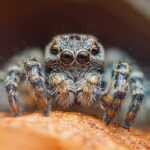We’ve finally started to see a little bit of winter this month. But spring will come – and faster than we think. Spring is always welcome after our cold, gray winters. But as we welcome sunshine, color, and longer days we also welcome back those creepy-crawly, busy-buzzy pests.
We don’t mind a few buzzing bugs. They add to the music of spring, and many are helpful and important for our lawns and gardens. But if we aren’t careful, there are species of insects that will create problems for homeowners and businesses with annoying, unhealthy, and sometimes dangerous infestations.
Preventing Bug Infestations
Coach used to say, “The best defense is a good offense.” Grandma said, “an ounce of prevention is worth a pound of cure” — actually, it was Benjamin Franklin, but we’ll let Grandma claim credit. They were right. It’s true for sports. It’s true for your health. And it’s true for controlling those pesky bugs. We like to say, “It is MUCH harder to control bugs after they’ve entered your home.”
Here are a few important steps you should take to KEEP BUGS OUT:
Bug-proof your home or business
Check your doors and windows for cracks or leaks. Add or replace damaged weather-stripping around doors. Inspect and replace damaged window caulking. Repair or replace torn window screens. Seal cracks and small openings at the foundation. Don’t give bugs an easy way in.
Keep clean indoors
The more often you clean, the more you disturb insects that have made their way inside. Clear anything that could attract bugs: don’t leave uncovered food out, remove pet food when your pet is finished eating, keep counters clean, and remove trash immediately. Don’t give bugs a chance to get comfortable in your home.
Clean-up insect habitats outdoors
Overwintering bugs seek shelter and water. Remove or empty anything that can collect standing water — empty pots, pet bowls, tires, and toys for example. Rake up leaves, clean up dead plants, and cut back weeds. Trim trees, bushes, and shrubs, especially those close to your home. The more maintained your landscape is, the less of a habitat you create for bugs.
Apply an exterior insect barrier
Even when you do everything right, we all need some professional help. The best way to keep bugs out, is to keep them from coming inside in the first place.
Quarterly Pest Control Programs
Applying an insect barrier in early spring is an important step in your “good offense” against spiders, ants, wasps, and other bugs. When you sign up now for a quarterly pest control program with us, you have one less thing to worry about. Our experienced and professional team will apply the spring barrier at the optimum time for preventing insects from entering your home. We will continue service throughout the bug season — every 90 days. We like to keep you in the loop with a twenty-four hour notice, but you don’t have to be home — no waiting around like you do for the Cable Guy.
Just For Fun . . . Ever Wondered Where Spring Bugs are Coming Back From?
Once the sun comes back you can be assured that the buzzing and creeping will follow. But, where have they been all winter? There is no one answer for this. Each species of insect has its own unique winter survival technique. Some insects will migrate just like birds do. Monarch butterflies, one of our more welcome and helpful species, migrate to Mexico. Certain varieties of dragonfly also migrate, spending the winter along the Pacific coast — we might be just a little jealous of these guys.
Most of our local insects go into what is called diapause. This is the insect version of hibernation. Adult insects or their larva slow all body functions and stop all development until the weather warms. Some burrow underground, others find a hidden covering, but all seek shelter to overwinter. House flies, for example, will find a little crack or crevice to rest until spring when they wake up to lay their eggs. Ever wonder where that one random fly came from when you haven’t even opened your windows yet? It’s probably been there all winter.
Here’s what some other common insects are up to in the winter:
- Wasps are a local overwintering pest we all know too well. Only the queen survives the cold. She abandons the colony and finds a place to shelter – maybe a loose piece of bark, some untrimmed bushes, or even a weedy garden area. Sometimes you will find one indoors hidden in the fold of your drapes or a window crevice. Don’t worry. . . in the winter wasps are extremely slow and usually in that diapause state we talked about earlier. However, when spring comes, you will see queen wasps literally racing against time to build a new nest for their eggs — in your eaves and gutters, on your patios and fences, and any other semi-sheltered place. They are desperate and they may be aggressive if disturbed.
- Like wasps, elm seed and boxelder bugs will overwinter by finding a sheltered spot outdoors. But if adults can find cracks in your windows or siding to slip under, they will spend the winter in your walls. Besides the obvious “ick factor”, these bugs can infest your home when it starts to warm up.
- Our least favorite Idaho insect, the mosquito, will lay eggs in standing water before winter. As the temperature drops the eggs going into diapause until spring rains and rising temperatures prompt development – then they hatch. These pests leave you swatting during your spring lawn clean-up and are not just a nuisance — they can be a health hazard. A study by The American Journal of Tropical Medicine and Hygiene found infected mother mosquitoes often pass viruses on to their larva, including the dangerous West Nile Virus found in our valley.
Defend Your PNW Home or Business from Pests Today
You don’t have to feel like you’re coming from behind in the pest game. Call PURCOR and choose our quarterly pest control program to give your Pacific Northwest home or business the best defense against pests.
"*" indicates required fields
"*" indicates required fields




